Essay: Digital Capabilities for Harnessing Innovation Opportunities
VerifiedAdded on 2023/06/07
|10
|2778
|221
Essay
AI Summary
This essay explores how companies develop digital capabilities to harness emerging innovation opportunities. It begins by defining digital transformation and its importance in today's technological world. The essay analyzes relevant literature, highlighting the role of digital technology in achieving business goals, improving connectivity, and enabling data collection and performance tracking. It also discusses the challenges businesses face, such as the high cost of technology and resistance to workplace transformation. The essay further examines the impact of digitalization on business performance, productivity, and supply chain management, particularly in the context of the Covid-19 pandemic. It concludes by emphasizing the importance of workplace transformation and digital capabilities for businesses to thrive in the future.
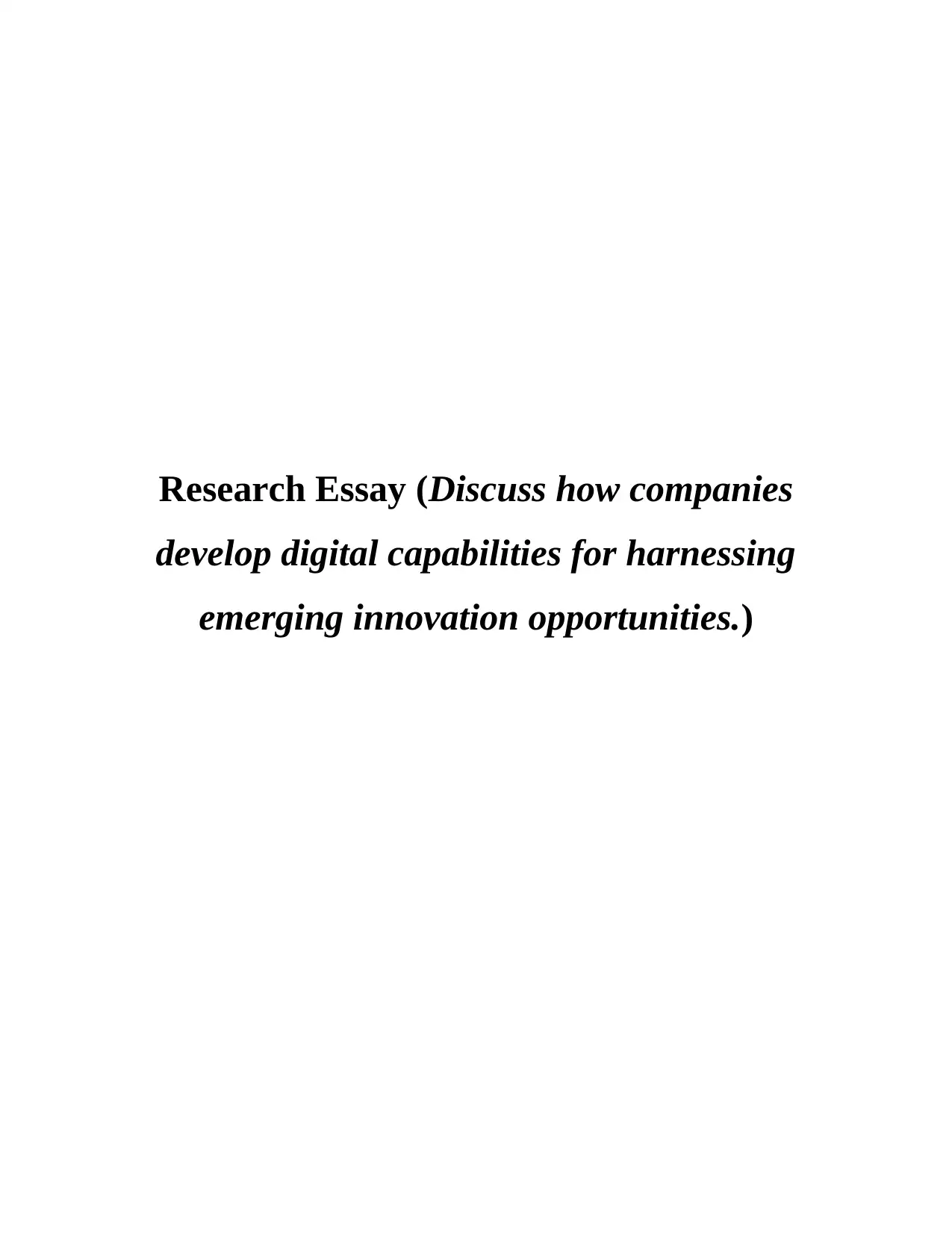
Research Essay (Discuss how companies
develop digital capabilities for harnessing
emerging innovation opportunities.)
develop digital capabilities for harnessing
emerging innovation opportunities.)
Paraphrase This Document
Need a fresh take? Get an instant paraphrase of this document with our AI Paraphraser

Table of Contents
Essay Topic: Discuss how companies develop digital capabilities for harnessing emerging
innovation opportunities..................................................................................................................3
Introduction......................................................................................................................................3
Critical analysis of relevant literature..............................................................................................3
Discussion of the main challenges, problems and issues businesses face in relation to the chosen
topic..................................................................................................................................................4
Conclusion discussion of the overall coverage of the topic including emerging trends about the
future................................................................................................................................................8
References........................................................................................................................................9
Essay Topic: Discuss how companies develop digital capabilities for harnessing emerging
innovation opportunities..................................................................................................................3
Introduction......................................................................................................................................3
Critical analysis of relevant literature..............................................................................................3
Discussion of the main challenges, problems and issues businesses face in relation to the chosen
topic..................................................................................................................................................4
Conclusion discussion of the overall coverage of the topic including emerging trends about the
future................................................................................................................................................8
References........................................................................................................................................9
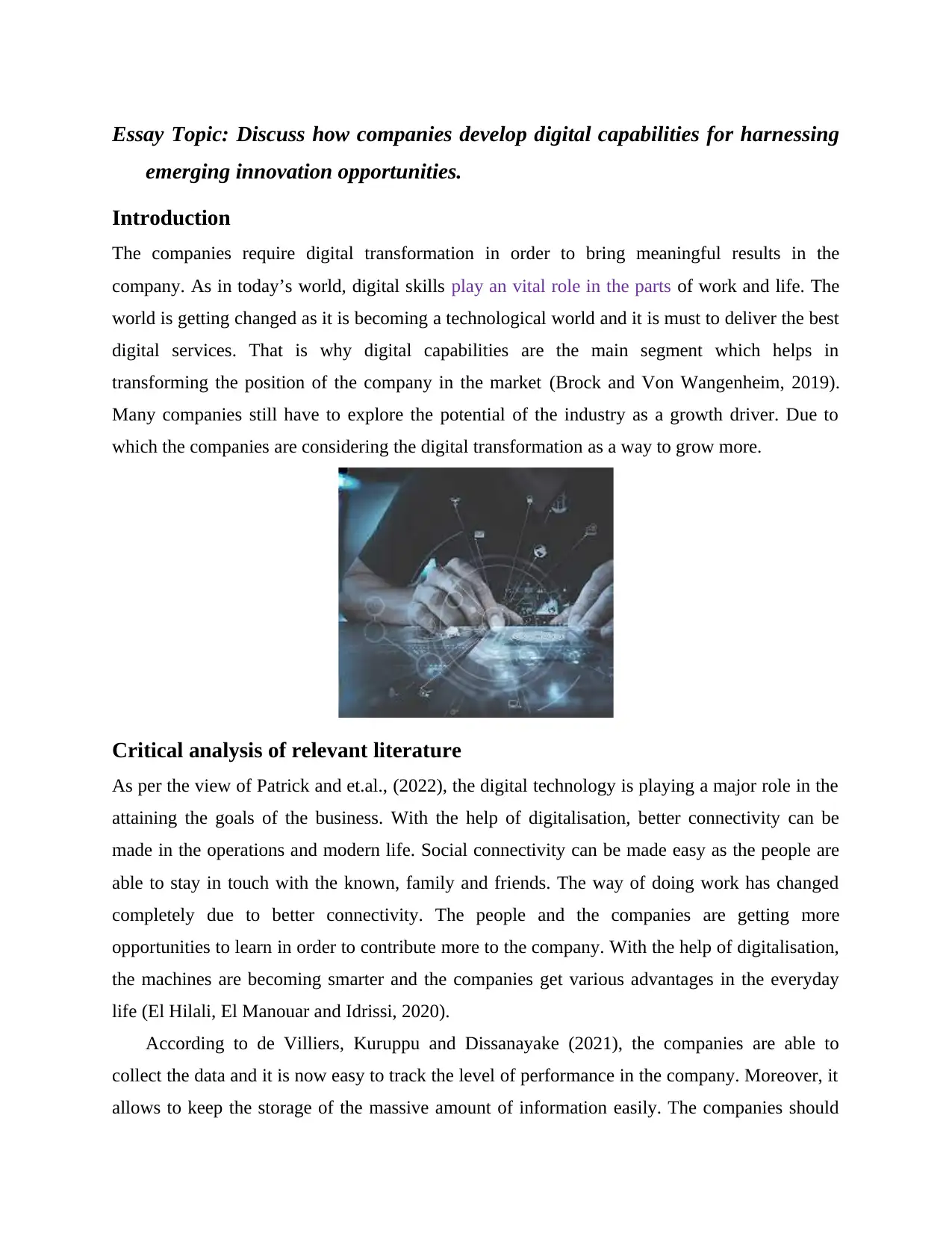
Essay Topic: Discuss how companies develop digital capabilities for harnessing
emerging innovation opportunities.
Introduction
The companies require digital transformation in order to bring meaningful results in the
company. As in today’s world, digital skills play an vital role in the parts of work and life. The
world is getting changed as it is becoming a technological world and it is must to deliver the best
digital services. That is why digital capabilities are the main segment which helps in
transforming the position of the company in the market (Brock and Von Wangenheim, 2019).
Many companies still have to explore the potential of the industry as a growth driver. Due to
which the companies are considering the digital transformation as a way to grow more.
Critical analysis of relevant literature
As per the view of Patrick and et.al., (2022), the digital technology is playing a major role in the
attaining the goals of the business. With the help of digitalisation, better connectivity can be
made in the operations and modern life. Social connectivity can be made easy as the people are
able to stay in touch with the known, family and friends. The way of doing work has changed
completely due to better connectivity. The people and the companies are getting more
opportunities to learn in order to contribute more to the company. With the help of digitalisation,
the machines are becoming smarter and the companies get various advantages in the everyday
life (El Hilali, El Manouar and Idrissi, 2020).
According to de Villiers, Kuruppu and Dissanayake (2021), the companies are able to
collect the data and it is now easy to track the level of performance in the company. Moreover, it
allows to keep the storage of the massive amount of information easily. The companies should
emerging innovation opportunities.
Introduction
The companies require digital transformation in order to bring meaningful results in the
company. As in today’s world, digital skills play an vital role in the parts of work and life. The
world is getting changed as it is becoming a technological world and it is must to deliver the best
digital services. That is why digital capabilities are the main segment which helps in
transforming the position of the company in the market (Brock and Von Wangenheim, 2019).
Many companies still have to explore the potential of the industry as a growth driver. Due to
which the companies are considering the digital transformation as a way to grow more.
Critical analysis of relevant literature
As per the view of Patrick and et.al., (2022), the digital technology is playing a major role in the
attaining the goals of the business. With the help of digitalisation, better connectivity can be
made in the operations and modern life. Social connectivity can be made easy as the people are
able to stay in touch with the known, family and friends. The way of doing work has changed
completely due to better connectivity. The people and the companies are getting more
opportunities to learn in order to contribute more to the company. With the help of digitalisation,
the machines are becoming smarter and the companies get various advantages in the everyday
life (El Hilali, El Manouar and Idrissi, 2020).
According to de Villiers, Kuruppu and Dissanayake (2021), the companies are able to
collect the data and it is now easy to track the level of performance in the company. Moreover, it
allows to keep the storage of the massive amount of information easily. The companies should
⊘ This is a preview!⊘
Do you want full access?
Subscribe today to unlock all pages.

Trusted by 1+ million students worldwide
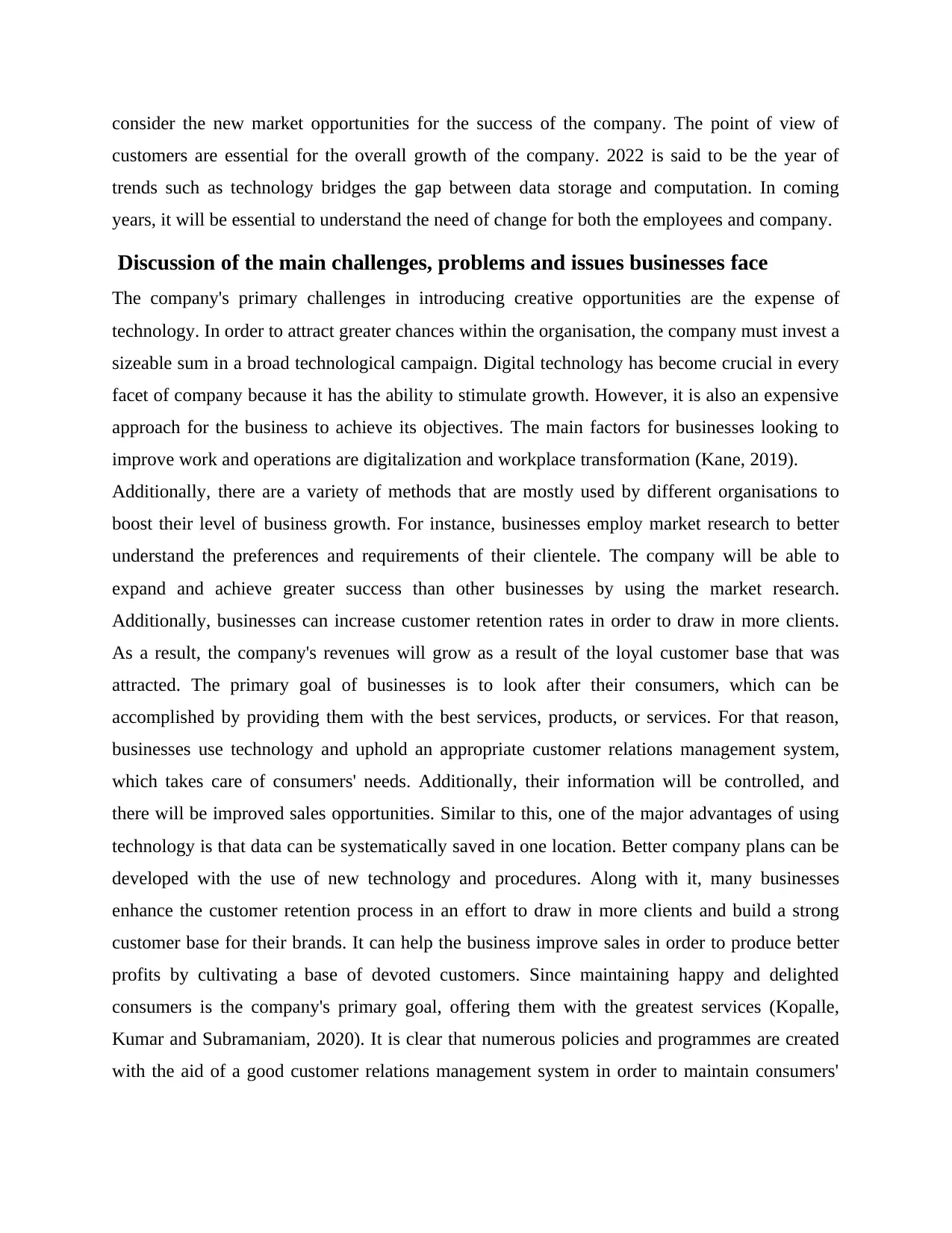
consider the new market opportunities for the success of the company. The point of view of
customers are essential for the overall growth of the company. 2022 is said to be the year of
trends such as technology bridges the gap between data storage and computation. In coming
years, it will be essential to understand the need of change for both the employees and company.
Discussion of the main challenges, problems and issues businesses face
The company's primary challenges in introducing creative opportunities are the expense of
technology. In order to attract greater chances within the organisation, the company must invest a
sizeable sum in a broad technological campaign. Digital technology has become crucial in every
facet of company because it has the ability to stimulate growth. However, it is also an expensive
approach for the business to achieve its objectives. The main factors for businesses looking to
improve work and operations are digitalization and workplace transformation (Kane, 2019).
Additionally, there are a variety of methods that are mostly used by different organisations to
boost their level of business growth. For instance, businesses employ market research to better
understand the preferences and requirements of their clientele. The company will be able to
expand and achieve greater success than other businesses by using the market research.
Additionally, businesses can increase customer retention rates in order to draw in more clients.
As a result, the company's revenues will grow as a result of the loyal customer base that was
attracted. The primary goal of businesses is to look after their consumers, which can be
accomplished by providing them with the best services, products, or services. For that reason,
businesses use technology and uphold an appropriate customer relations management system,
which takes care of consumers' needs. Additionally, their information will be controlled, and
there will be improved sales opportunities. Similar to this, one of the major advantages of using
technology is that data can be systematically saved in one location. Better company plans can be
developed with the use of new technology and procedures. Along with it, many businesses
enhance the customer retention process in an effort to draw in more clients and build a strong
customer base for their brands. It can help the business improve sales in order to produce better
profits by cultivating a base of devoted customers. Since maintaining happy and delighted
consumers is the company's primary goal, offering them with the greatest services (Kopalle,
Kumar and Subramaniam, 2020). It is clear that numerous policies and programmes are created
with the aid of a good customer relations management system in order to maintain consumers'
customers are essential for the overall growth of the company. 2022 is said to be the year of
trends such as technology bridges the gap between data storage and computation. In coming
years, it will be essential to understand the need of change for both the employees and company.
Discussion of the main challenges, problems and issues businesses face
The company's primary challenges in introducing creative opportunities are the expense of
technology. In order to attract greater chances within the organisation, the company must invest a
sizeable sum in a broad technological campaign. Digital technology has become crucial in every
facet of company because it has the ability to stimulate growth. However, it is also an expensive
approach for the business to achieve its objectives. The main factors for businesses looking to
improve work and operations are digitalization and workplace transformation (Kane, 2019).
Additionally, there are a variety of methods that are mostly used by different organisations to
boost their level of business growth. For instance, businesses employ market research to better
understand the preferences and requirements of their clientele. The company will be able to
expand and achieve greater success than other businesses by using the market research.
Additionally, businesses can increase customer retention rates in order to draw in more clients.
As a result, the company's revenues will grow as a result of the loyal customer base that was
attracted. The primary goal of businesses is to look after their consumers, which can be
accomplished by providing them with the best services, products, or services. For that reason,
businesses use technology and uphold an appropriate customer relations management system,
which takes care of consumers' needs. Additionally, their information will be controlled, and
there will be improved sales opportunities. Similar to this, one of the major advantages of using
technology is that data can be systematically saved in one location. Better company plans can be
developed with the use of new technology and procedures. Along with it, many businesses
enhance the customer retention process in an effort to draw in more clients and build a strong
customer base for their brands. It can help the business improve sales in order to produce better
profits by cultivating a base of devoted customers. Since maintaining happy and delighted
consumers is the company's primary goal, offering them with the greatest services (Kopalle,
Kumar and Subramaniam, 2020). It is clear that numerous policies and programmes are created
with the aid of a good customer relations management system in order to maintain consumers'
Paraphrase This Document
Need a fresh take? Get an instant paraphrase of this document with our AI Paraphraser
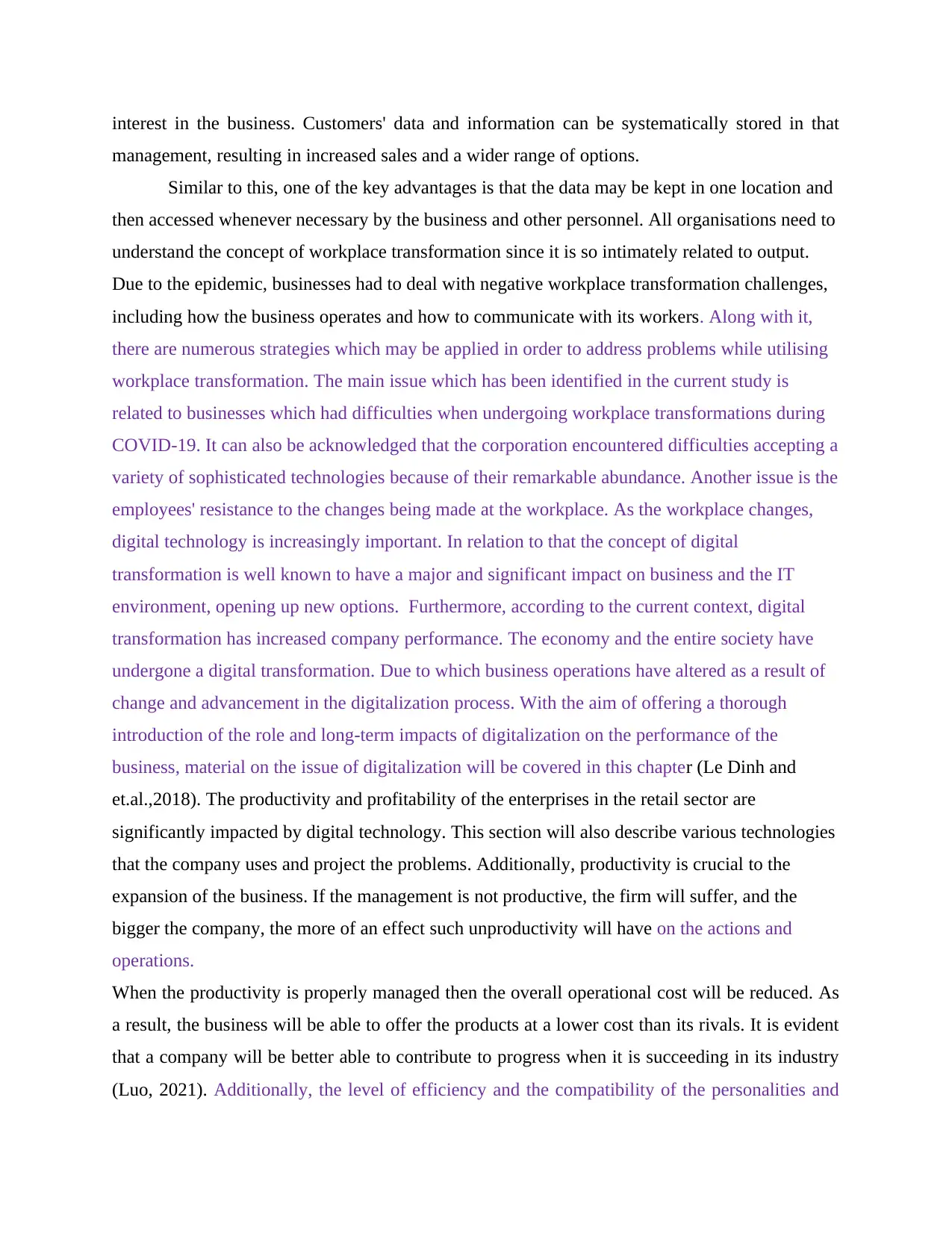
interest in the business. Customers' data and information can be systematically stored in that
management, resulting in increased sales and a wider range of options.
Similar to this, one of the key advantages is that the data may be kept in one location and
then accessed whenever necessary by the business and other personnel. All organisations need to
understand the concept of workplace transformation since it is so intimately related to output.
Due to the epidemic, businesses had to deal with negative workplace transformation challenges,
including how the business operates and how to communicate with its workers. Along with it,
there are numerous strategies which may be applied in order to address problems while utilising
workplace transformation. The main issue which has been identified in the current study is
related to businesses which had difficulties when undergoing workplace transformations during
COVID-19. It can also be acknowledged that the corporation encountered difficulties accepting a
variety of sophisticated technologies because of their remarkable abundance. Another issue is the
employees' resistance to the changes being made at the workplace. As the workplace changes,
digital technology is increasingly important. In relation to that the concept of digital
transformation is well known to have a major and significant impact on business and the IT
environment, opening up new options. Furthermore, according to the current context, digital
transformation has increased company performance. The economy and the entire society have
undergone a digital transformation. Due to which business operations have altered as a result of
change and advancement in the digitalization process. With the aim of offering a thorough
introduction of the role and long-term impacts of digitalization on the performance of the
business, material on the issue of digitalization will be covered in this chapter (Le Dinh and
et.al.,2018). The productivity and profitability of the enterprises in the retail sector are
significantly impacted by digital technology. This section will also describe various technologies
that the company uses and project the problems. Additionally, productivity is crucial to the
expansion of the business. If the management is not productive, the firm will suffer, and the
bigger the company, the more of an effect such unproductivity will have on the actions and
operations.
When the productivity is properly managed then the overall operational cost will be reduced. As
a result, the business will be able to offer the products at a lower cost than its rivals. It is evident
that a company will be better able to contribute to progress when it is succeeding in its industry
(Luo, 2021). Additionally, the level of efficiency and the compatibility of the personalities and
management, resulting in increased sales and a wider range of options.
Similar to this, one of the key advantages is that the data may be kept in one location and
then accessed whenever necessary by the business and other personnel. All organisations need to
understand the concept of workplace transformation since it is so intimately related to output.
Due to the epidemic, businesses had to deal with negative workplace transformation challenges,
including how the business operates and how to communicate with its workers. Along with it,
there are numerous strategies which may be applied in order to address problems while utilising
workplace transformation. The main issue which has been identified in the current study is
related to businesses which had difficulties when undergoing workplace transformations during
COVID-19. It can also be acknowledged that the corporation encountered difficulties accepting a
variety of sophisticated technologies because of their remarkable abundance. Another issue is the
employees' resistance to the changes being made at the workplace. As the workplace changes,
digital technology is increasingly important. In relation to that the concept of digital
transformation is well known to have a major and significant impact on business and the IT
environment, opening up new options. Furthermore, according to the current context, digital
transformation has increased company performance. The economy and the entire society have
undergone a digital transformation. Due to which business operations have altered as a result of
change and advancement in the digitalization process. With the aim of offering a thorough
introduction of the role and long-term impacts of digitalization on the performance of the
business, material on the issue of digitalization will be covered in this chapter (Le Dinh and
et.al.,2018). The productivity and profitability of the enterprises in the retail sector are
significantly impacted by digital technology. This section will also describe various technologies
that the company uses and project the problems. Additionally, productivity is crucial to the
expansion of the business. If the management is not productive, the firm will suffer, and the
bigger the company, the more of an effect such unproductivity will have on the actions and
operations.
When the productivity is properly managed then the overall operational cost will be reduced. As
a result, the business will be able to offer the products at a lower cost than its rivals. It is evident
that a company will be better able to contribute to progress when it is succeeding in its industry
(Luo, 2021). Additionally, the level of efficiency and the compatibility of the personalities and
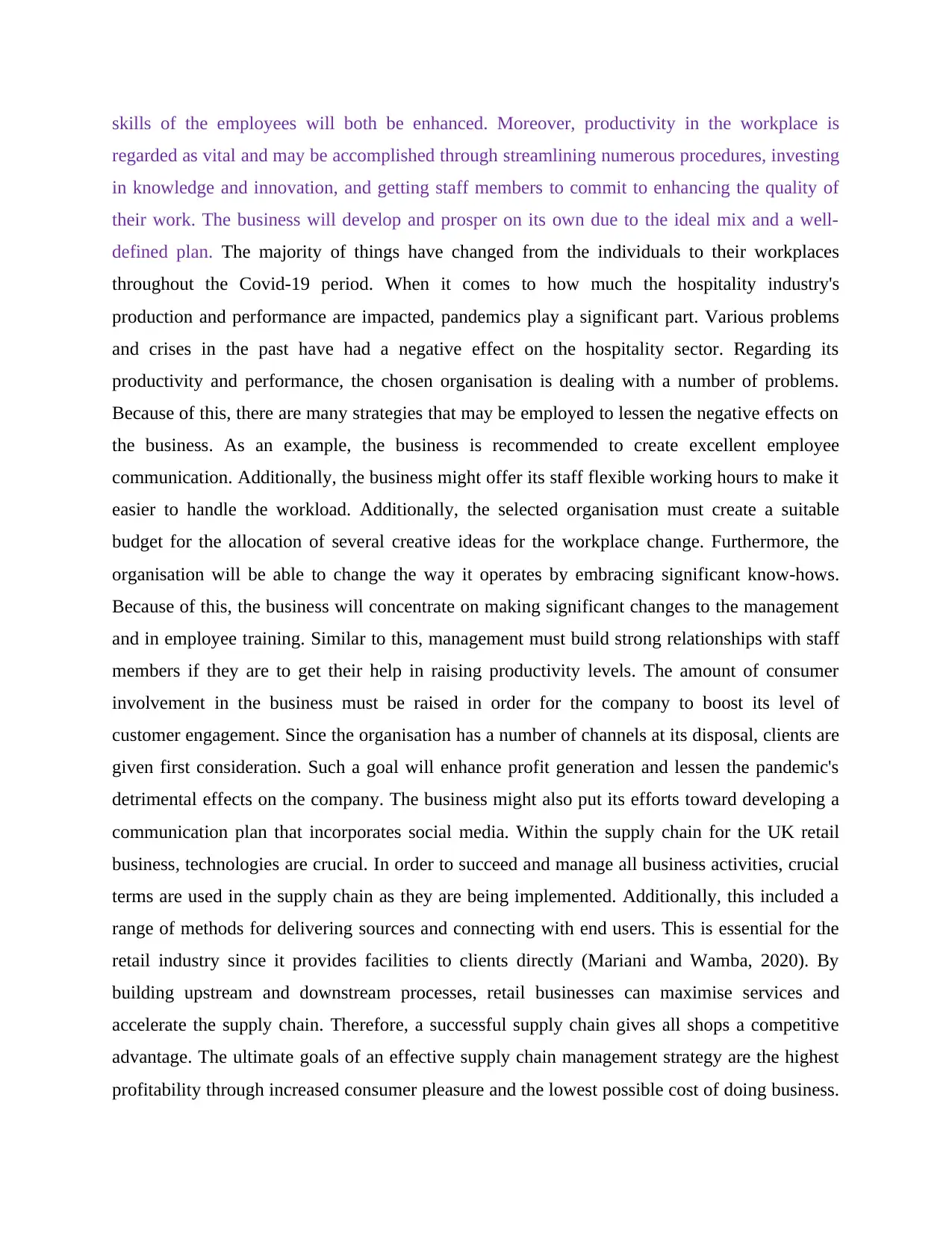
skills of the employees will both be enhanced. Moreover, productivity in the workplace is
regarded as vital and may be accomplished through streamlining numerous procedures, investing
in knowledge and innovation, and getting staff members to commit to enhancing the quality of
their work. The business will develop and prosper on its own due to the ideal mix and a well-
defined plan. The majority of things have changed from the individuals to their workplaces
throughout the Covid-19 period. When it comes to how much the hospitality industry's
production and performance are impacted, pandemics play a significant part. Various problems
and crises in the past have had a negative effect on the hospitality sector. Regarding its
productivity and performance, the chosen organisation is dealing with a number of problems.
Because of this, there are many strategies that may be employed to lessen the negative effects on
the business. As an example, the business is recommended to create excellent employee
communication. Additionally, the business might offer its staff flexible working hours to make it
easier to handle the workload. Additionally, the selected organisation must create a suitable
budget for the allocation of several creative ideas for the workplace change. Furthermore, the
organisation will be able to change the way it operates by embracing significant know-hows.
Because of this, the business will concentrate on making significant changes to the management
and in employee training. Similar to this, management must build strong relationships with staff
members if they are to get their help in raising productivity levels. The amount of consumer
involvement in the business must be raised in order for the company to boost its level of
customer engagement. Since the organisation has a number of channels at its disposal, clients are
given first consideration. Such a goal will enhance profit generation and lessen the pandemic's
detrimental effects on the company. The business might also put its efforts toward developing a
communication plan that incorporates social media. Within the supply chain for the UK retail
business, technologies are crucial. In order to succeed and manage all business activities, crucial
terms are used in the supply chain as they are being implemented. Additionally, this included a
range of methods for delivering sources and connecting with end users. This is essential for the
retail industry since it provides facilities to clients directly (Mariani and Wamba, 2020). By
building upstream and downstream processes, retail businesses can maximise services and
accelerate the supply chain. Therefore, a successful supply chain gives all shops a competitive
advantage. The ultimate goals of an effective supply chain management strategy are the highest
profitability through increased consumer pleasure and the lowest possible cost of doing business.
regarded as vital and may be accomplished through streamlining numerous procedures, investing
in knowledge and innovation, and getting staff members to commit to enhancing the quality of
their work. The business will develop and prosper on its own due to the ideal mix and a well-
defined plan. The majority of things have changed from the individuals to their workplaces
throughout the Covid-19 period. When it comes to how much the hospitality industry's
production and performance are impacted, pandemics play a significant part. Various problems
and crises in the past have had a negative effect on the hospitality sector. Regarding its
productivity and performance, the chosen organisation is dealing with a number of problems.
Because of this, there are many strategies that may be employed to lessen the negative effects on
the business. As an example, the business is recommended to create excellent employee
communication. Additionally, the business might offer its staff flexible working hours to make it
easier to handle the workload. Additionally, the selected organisation must create a suitable
budget for the allocation of several creative ideas for the workplace change. Furthermore, the
organisation will be able to change the way it operates by embracing significant know-hows.
Because of this, the business will concentrate on making significant changes to the management
and in employee training. Similar to this, management must build strong relationships with staff
members if they are to get their help in raising productivity levels. The amount of consumer
involvement in the business must be raised in order for the company to boost its level of
customer engagement. Since the organisation has a number of channels at its disposal, clients are
given first consideration. Such a goal will enhance profit generation and lessen the pandemic's
detrimental effects on the company. The business might also put its efforts toward developing a
communication plan that incorporates social media. Within the supply chain for the UK retail
business, technologies are crucial. In order to succeed and manage all business activities, crucial
terms are used in the supply chain as they are being implemented. Additionally, this included a
range of methods for delivering sources and connecting with end users. This is essential for the
retail industry since it provides facilities to clients directly (Mariani and Wamba, 2020). By
building upstream and downstream processes, retail businesses can maximise services and
accelerate the supply chain. Therefore, a successful supply chain gives all shops a competitive
advantage. The ultimate goals of an effective supply chain management strategy are the highest
profitability through increased consumer pleasure and the lowest possible cost of doing business.
⊘ This is a preview!⊘
Do you want full access?
Subscribe today to unlock all pages.

Trusted by 1+ million students worldwide
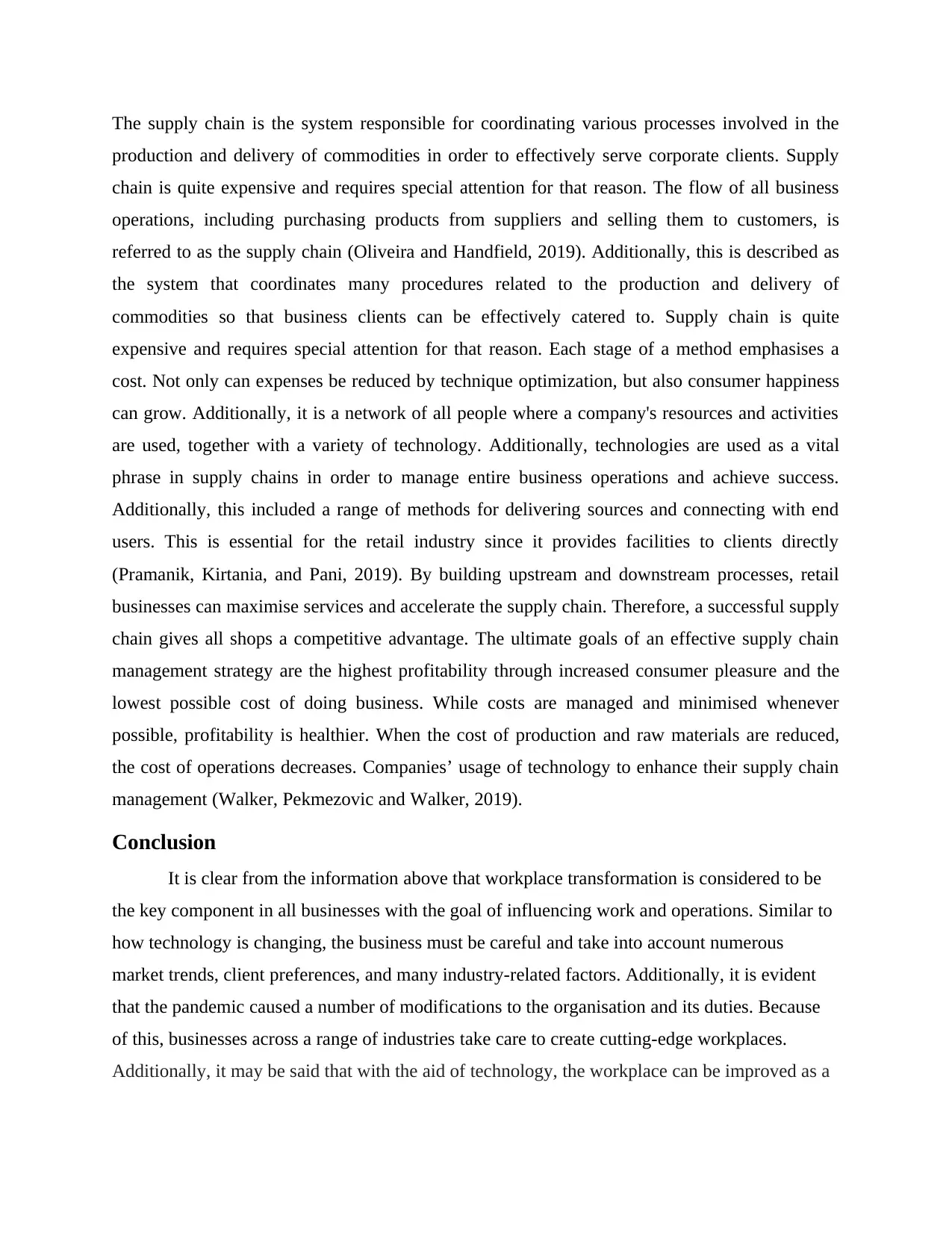
The supply chain is the system responsible for coordinating various processes involved in the
production and delivery of commodities in order to effectively serve corporate clients. Supply
chain is quite expensive and requires special attention for that reason. The flow of all business
operations, including purchasing products from suppliers and selling them to customers, is
referred to as the supply chain (Oliveira and Handfield, 2019). Additionally, this is described as
the system that coordinates many procedures related to the production and delivery of
commodities so that business clients can be effectively catered to. Supply chain is quite
expensive and requires special attention for that reason. Each stage of a method emphasises a
cost. Not only can expenses be reduced by technique optimization, but also consumer happiness
can grow. Additionally, it is a network of all people where a company's resources and activities
are used, together with a variety of technology. Additionally, technologies are used as a vital
phrase in supply chains in order to manage entire business operations and achieve success.
Additionally, this included a range of methods for delivering sources and connecting with end
users. This is essential for the retail industry since it provides facilities to clients directly
(Pramanik, Kirtania, and Pani, 2019). By building upstream and downstream processes, retail
businesses can maximise services and accelerate the supply chain. Therefore, a successful supply
chain gives all shops a competitive advantage. The ultimate goals of an effective supply chain
management strategy are the highest profitability through increased consumer pleasure and the
lowest possible cost of doing business. While costs are managed and minimised whenever
possible, profitability is healthier. When the cost of production and raw materials are reduced,
the cost of operations decreases. Companies’ usage of technology to enhance their supply chain
management (Walker, Pekmezovic and Walker, 2019).
Conclusion
It is clear from the information above that workplace transformation is considered to be
the key component in all businesses with the goal of influencing work and operations. Similar to
how technology is changing, the business must be careful and take into account numerous
market trends, client preferences, and many industry-related factors. Additionally, it is evident
that the pandemic caused a number of modifications to the organisation and its duties. Because
of this, businesses across a range of industries take care to create cutting-edge workplaces.
Additionally, it may be said that with the aid of technology, the workplace can be improved as a
production and delivery of commodities in order to effectively serve corporate clients. Supply
chain is quite expensive and requires special attention for that reason. The flow of all business
operations, including purchasing products from suppliers and selling them to customers, is
referred to as the supply chain (Oliveira and Handfield, 2019). Additionally, this is described as
the system that coordinates many procedures related to the production and delivery of
commodities so that business clients can be effectively catered to. Supply chain is quite
expensive and requires special attention for that reason. Each stage of a method emphasises a
cost. Not only can expenses be reduced by technique optimization, but also consumer happiness
can grow. Additionally, it is a network of all people where a company's resources and activities
are used, together with a variety of technology. Additionally, technologies are used as a vital
phrase in supply chains in order to manage entire business operations and achieve success.
Additionally, this included a range of methods for delivering sources and connecting with end
users. This is essential for the retail industry since it provides facilities to clients directly
(Pramanik, Kirtania, and Pani, 2019). By building upstream and downstream processes, retail
businesses can maximise services and accelerate the supply chain. Therefore, a successful supply
chain gives all shops a competitive advantage. The ultimate goals of an effective supply chain
management strategy are the highest profitability through increased consumer pleasure and the
lowest possible cost of doing business. While costs are managed and minimised whenever
possible, profitability is healthier. When the cost of production and raw materials are reduced,
the cost of operations decreases. Companies’ usage of technology to enhance their supply chain
management (Walker, Pekmezovic and Walker, 2019).
Conclusion
It is clear from the information above that workplace transformation is considered to be
the key component in all businesses with the goal of influencing work and operations. Similar to
how technology is changing, the business must be careful and take into account numerous
market trends, client preferences, and many industry-related factors. Additionally, it is evident
that the pandemic caused a number of modifications to the organisation and its duties. Because
of this, businesses across a range of industries take care to create cutting-edge workplaces.
Additionally, it may be said that with the aid of technology, the workplace can be improved as a
Paraphrase This Document
Need a fresh take? Get an instant paraphrase of this document with our AI Paraphraser

place to work. If the right tools and technology are employed, the company's operations will also
be improved. These actions and projects will raise the company's performance bar.
be improved. These actions and projects will raise the company's performance bar.
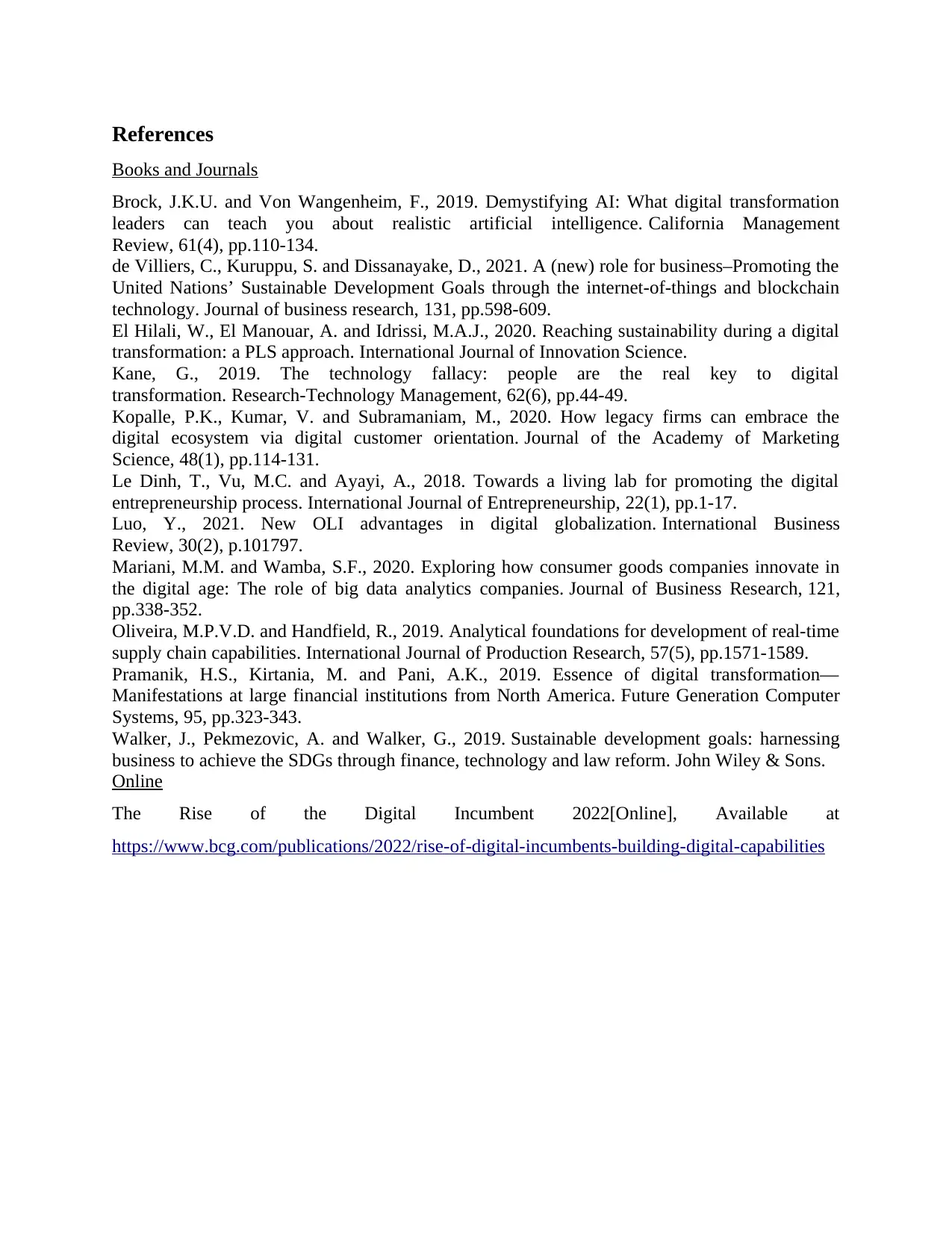
References
Books and Journals
Brock, J.K.U. and Von Wangenheim, F., 2019. Demystifying AI: What digital transformation
leaders can teach you about realistic artificial intelligence. California Management
Review, 61(4), pp.110-134.
de Villiers, C., Kuruppu, S. and Dissanayake, D., 2021. A (new) role for business–Promoting the
United Nations’ Sustainable Development Goals through the internet-of-things and blockchain
technology. Journal of business research, 131, pp.598-609.
El Hilali, W., El Manouar, A. and Idrissi, M.A.J., 2020. Reaching sustainability during a digital
transformation: a PLS approach. International Journal of Innovation Science.
Kane, G., 2019. The technology fallacy: people are the real key to digital
transformation. Research-Technology Management, 62(6), pp.44-49.
Kopalle, P.K., Kumar, V. and Subramaniam, M., 2020. How legacy firms can embrace the
digital ecosystem via digital customer orientation. Journal of the Academy of Marketing
Science, 48(1), pp.114-131.
Le Dinh, T., Vu, M.C. and Ayayi, A., 2018. Towards a living lab for promoting the digital
entrepreneurship process. International Journal of Entrepreneurship, 22(1), pp.1-17.
Luo, Y., 2021. New OLI advantages in digital globalization. International Business
Review, 30(2), p.101797.
Mariani, M.M. and Wamba, S.F., 2020. Exploring how consumer goods companies innovate in
the digital age: The role of big data analytics companies. Journal of Business Research, 121,
pp.338-352.
Oliveira, M.P.V.D. and Handfield, R., 2019. Analytical foundations for development of real-time
supply chain capabilities. International Journal of Production Research, 57(5), pp.1571-1589.
Pramanik, H.S., Kirtania, M. and Pani, A.K., 2019. Essence of digital transformation—
Manifestations at large financial institutions from North America. Future Generation Computer
Systems, 95, pp.323-343.
Walker, J., Pekmezovic, A. and Walker, G., 2019. Sustainable development goals: harnessing
business to achieve the SDGs through finance, technology and law reform. John Wiley & Sons.
Online
The Rise of the Digital Incumbent 2022[Online], Available at
https://www.bcg.com/publications/2022/rise-of-digital-incumbents-building-digital-capabilities
Books and Journals
Brock, J.K.U. and Von Wangenheim, F., 2019. Demystifying AI: What digital transformation
leaders can teach you about realistic artificial intelligence. California Management
Review, 61(4), pp.110-134.
de Villiers, C., Kuruppu, S. and Dissanayake, D., 2021. A (new) role for business–Promoting the
United Nations’ Sustainable Development Goals through the internet-of-things and blockchain
technology. Journal of business research, 131, pp.598-609.
El Hilali, W., El Manouar, A. and Idrissi, M.A.J., 2020. Reaching sustainability during a digital
transformation: a PLS approach. International Journal of Innovation Science.
Kane, G., 2019. The technology fallacy: people are the real key to digital
transformation. Research-Technology Management, 62(6), pp.44-49.
Kopalle, P.K., Kumar, V. and Subramaniam, M., 2020. How legacy firms can embrace the
digital ecosystem via digital customer orientation. Journal of the Academy of Marketing
Science, 48(1), pp.114-131.
Le Dinh, T., Vu, M.C. and Ayayi, A., 2018. Towards a living lab for promoting the digital
entrepreneurship process. International Journal of Entrepreneurship, 22(1), pp.1-17.
Luo, Y., 2021. New OLI advantages in digital globalization. International Business
Review, 30(2), p.101797.
Mariani, M.M. and Wamba, S.F., 2020. Exploring how consumer goods companies innovate in
the digital age: The role of big data analytics companies. Journal of Business Research, 121,
pp.338-352.
Oliveira, M.P.V.D. and Handfield, R., 2019. Analytical foundations for development of real-time
supply chain capabilities. International Journal of Production Research, 57(5), pp.1571-1589.
Pramanik, H.S., Kirtania, M. and Pani, A.K., 2019. Essence of digital transformation—
Manifestations at large financial institutions from North America. Future Generation Computer
Systems, 95, pp.323-343.
Walker, J., Pekmezovic, A. and Walker, G., 2019. Sustainable development goals: harnessing
business to achieve the SDGs through finance, technology and law reform. John Wiley & Sons.
Online
The Rise of the Digital Incumbent 2022[Online], Available at
https://www.bcg.com/publications/2022/rise-of-digital-incumbents-building-digital-capabilities
⊘ This is a preview!⊘
Do you want full access?
Subscribe today to unlock all pages.

Trusted by 1+ million students worldwide

1 out of 10
Related Documents
Your All-in-One AI-Powered Toolkit for Academic Success.
+13062052269
info@desklib.com
Available 24*7 on WhatsApp / Email
![[object Object]](/_next/static/media/star-bottom.7253800d.svg)
Unlock your academic potential
Copyright © 2020–2025 A2Z Services. All Rights Reserved. Developed and managed by ZUCOL.





